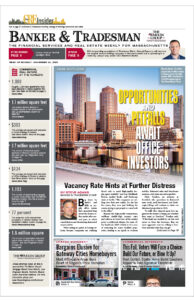
Rick Dimino
In Massachusetts, there is a recent pattern of new governors pushing for major changes at the MBTA. This year is no different; in fact, there is more urgency than ever before considering the condition of the public transit system. Gov. Maura Healey’s new appointments to MBTA management and board placed the right talent at the agency. Now, it is imperative to harness their expertise and ideas for reshaping the MBTA into a modern transportation system.
The past two Massachusetts governors both filed legislation early in their first terms to change the MBTA. Gov. Deval Patrick signed a plan that eliminated the Turnpike Authority, created a unified MassDOT and revised the retirement and benefit plans for the MBTA. Gov. Charlie Baker created a small, dedicated Fiscal and Management Control Board and secured waivers from the state’s Pacheco Law during the immediate years after the MBTA collapsed during the winter of 2015.
Both changes led to some short- and long-term improvements, but today the MBTA faces new challenges to its workforce, budget projections safety and systemwide infrastructure. This is a critical time for the MBTA to continue its evolution and new legislation can be a catalyst forward.
A To-Do List for Progress
Gov. Healey should look to the new, experienced leaders at the MBTA to advise on shaping legislation that takes best practices from other peer transportation agencies related to capital delivery, procurement and customer service. A package of reform and revenue plans in 2023 should include authority for public-private partnerships, joint development authority at MBTA facilities, with a specific focus on modernizing bus maintenance facilities, and a long-term transportation finance plan that addressing both the operating and capital infrastructure budgets.
The authors of this possible legislation are likely the same new hires who are in MBTA leadership positions. The MBTA board of directors is now chaired by Tom Glynn, who successfully led Massport for many years and is a former General Manager of the MBTA. The current General Manager, Phil Eng led a turnaround of the Long Island Rail Road and worked in multiple transportation agencies in the state of New York. So, it is fair to ask them what rules and policies worked in those transportation organizations that are not allowed under current state law for the MBTA?
The immediate focus should be getting the system safe and reliable, which likely requires some changes in procurement rules and new revenue. However, when we think of the foundational aspects of the MBTA, like the staircase, elevators and escalators, there should be a way to fix these components without bureaucratic challenges so that riders and MBTA customers can utilize safe infrastructure. It is unacceptable for the MBTA system’s escalators to not be repaired quickly, and hard to image this would happen at Massport or in other transit systems throughout the nation. If new legislation is needed to adopt the same rules and standards for efficient and timely maintenance and repairs, then this could be a center piece in delivering change for the public transit riders of this region.
Additionally, we must explore the legal obstacles for transforming the commuter rail system into a cleaner, more reliable system. Legislation should allow for a long-term contract for the operator of the commuter rail system so that the private operator would be expected to contribute to infrastructure improvements that help decarbonize the rail system. The MBTA faces significant challenges in delivering systemwide improvements at the pace required for Greater Boston’s economic growth and climate goals. This next legislative plan should seek to simplify this process, and reduce the uncertainty and risk for a commuter rail operator to be a successful partner with the commonwealth.
Time to Fix T’s Budget
Naturally, this would be the right opportunity to fix the budget. The MBTA is facing a substantial operating funding gap in the next year. However, the bigger challenge is likely with the unfunded need for capital improvements and enhancements like the Red-Blue Connector and regional rail. There are opportunities for new bonding against the revenue that is now available from the Millionaire’s Tax amendment that could make a substantial difference in the MBTA’s capital spending plans.
Finally, there is one more reason to push for this approach. Introducing new legislation would send a powerful message to riders, businesses, and residents that the MBTA is committed to becoming a modern, equitable, and environmentally friendly system. Legislation would say that the that the existing structure wants to change to deliver on these goals. There should be some urgency to break away from the status quo, which has resulted in system failures, budget deficits and declining ridership.
Aligning the talent that is now in place with the best tools and resources available can lead to a more promising future for transportation in Greater Boston. This year presents a real opportunity to address the biggest challenges for the MBTA and our economy that depends on reliable public transit. Let us seize this moment to empower the MBTA, foster collaboration and produce a new transit system that will be an effective driver of our region’s progress.
Rick Dimino is president emeritus of A Better City.





